power steering Hyundai Equus 2016 Owner's Manual
[x] Cancel search | Manufacturer: HYUNDAI, Model Year: 2016, Model line: Equus, Model: Hyundai Equus 2016Pages: 477, PDF Size: 16.25 MB
Page 15 of 477
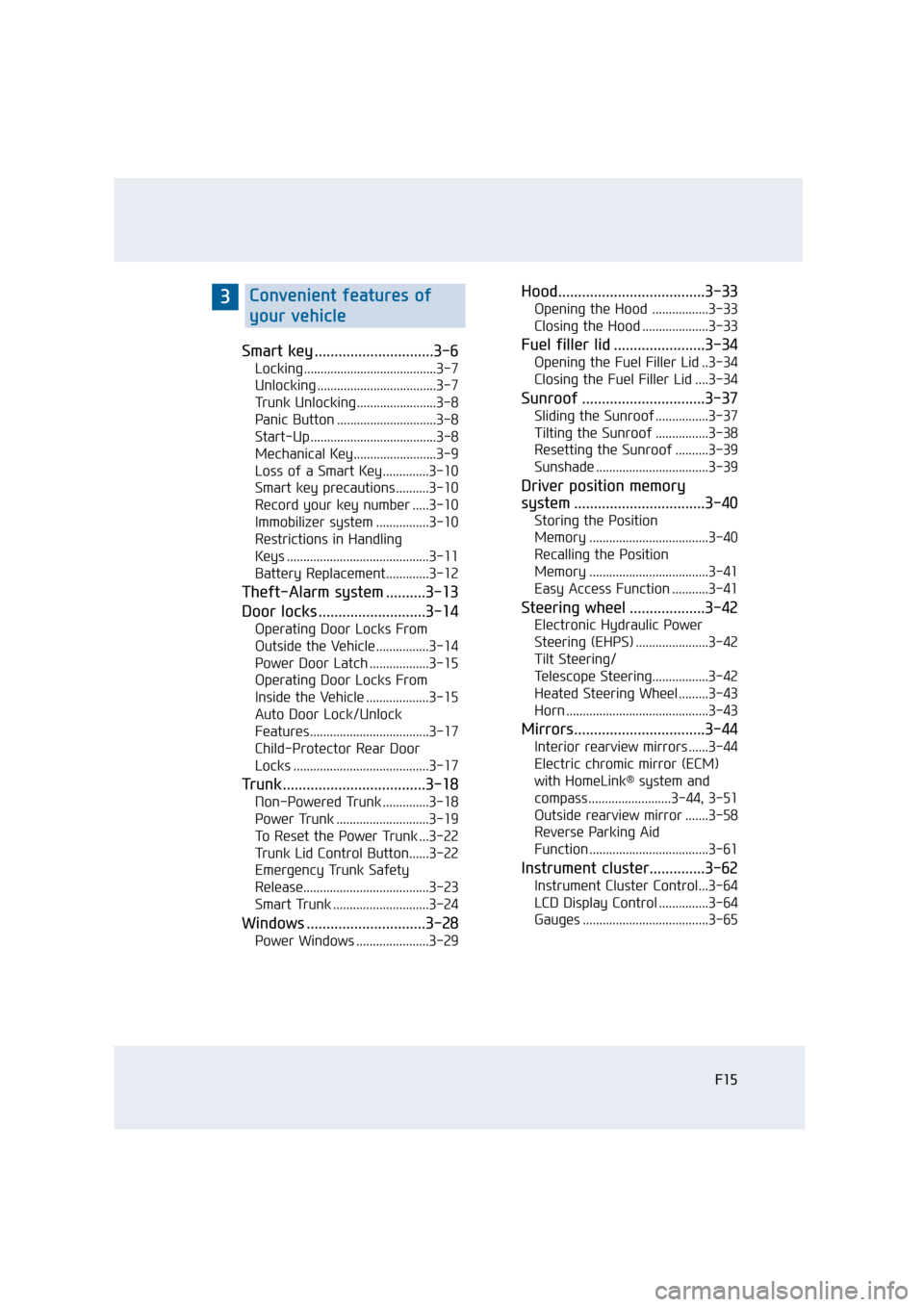
Smart key ..............................3-6
Locking ........................................3-7
Unlocking ....................................3-7
Trunk Unlocking ........................3-8
Panic Button ..............................3-8
Start-Up ......................................3-8
Mechanical Key.........................3-9
Loss of a Smart Key..............3-10
Smart key precautions..........3-10
Record your key number .....3-10
Immobilizer system ................3-10
Restrictions in Handling
Keys ...........................................3-11
Battery Replacement.............3-12
Theft-Alarm system ..........3-13
Door locks ...........................3-14
Operating Door Locks From
Outside the Vehicle ................3-14
Power Door Latch ..................3-15
Operating Door Locks From
Inside the Vehicle ...................3-15
Auto Door Lock/Unlock
Features....................................3-17
Child-Protector Rear Door
Locks .........................................3-17
Trunk....................................3-18
Non-Powered Trunk ..............3-18
Power Trunk ............................3-19
To Reset the Power Trunk ...3-22
Trunk Lid Control Button......3-22
Emergency Trunk Safety
Release......................................3-23
Smart Trunk .............................3-24
Windows ..............................3-28
Power Windows ......................3-29
Hood.....................................3-33
Opening the Hood .................3-33
Closing the Hood ....................3-33
Fuel filler lid .......................3-34
Opening the Fuel Filler Lid ..3-34
Closing the Fuel Filler Lid ....3-34
Sunroof ...............................3-37
Sliding the Sunroof ................3-37
Tilting the Sunroof ................3-38
Resetting the Sunroof ..........3-39
Sunshade ..................................3-39
Driver position memory
system .................................3-40
Storing the Position
Memory ....................................3-40
Recalling the Position
Memory ....................................3-41
Easy Access Function ...........3-41
Steering wheel ...................3-42
Electronic Hydraulic Power
Steering (EHPS) ......................3-42
Tilt Steering/
Telescope Steering.................3-42
Heated Steering Wheel .........3-43
Horn ...........................................3-43
Mirrors.................................3-44
Interior rearview mirrors ......3-44
Electric chromic mirror (ECM)
with HomeLink
®system and
compass .........................3-44, 3-51
Outside rearview mirror .......3-58
Reverse Parking Aid
Function ....................................3-61
Instrument cluster..............3-62
Instrument Cluster Control...3-64
LCD Display Control ...............3-64
Gauges ......................................3-65
F15
3Convenient features of
your vehicle
Page 17 of 477

Interior features...............3-145
Ashtray ...................................3-145
Cup holder..............................3-146
Sunvisor ..................................3-147
Rear vanity mirror ...............3-147
Power outlet ..........................3-148
Clock ........................................3-149
Clothes hanger......................3-150
Bag hanger ............................3-150
Floor mat anchor(s).............3-150
Luggage net (holder) ..........3-151
Rear curtain...........................3-152
AUX, USB and iPod
®port ..3-153
Multimedia system ...............4-2
Antenna.......................................4-2
Steering wheel audio
control .........................................4-3
Before driving ......................5-5
Before entering vehicle ..........5-5
Necessary inspections ............5-5
Before starting ........................5-5
Engine start/stop button ....5-7
Illuminated Engine Start/Stop
Button..........................................5-7
Engine Start/Stop Button
position........................................5-7
Starting the engine..............5-9
Automatic transmission.....5-11
Automatic transmission
operation ..................................5-12
Good driving practices ..........5-15
Brake system ......................5-17
Power brakes ..........................5-17
Electric parking brake
(EPB)..........................................5-19
Emergency braking ................5-22
AUTO HOLD .............................5-23
Anti-lock brake system
(ABS)..........................................5-26
Electronic stability control
(ESC) ..........................................5-28
Hill-start assist control
(HAC) .........................................5-32
Good braking practices.........5-32
Drive mode integrated
control system....................5-34
DRIVE mode / SNOW mode ..5-34
Electronic controlled
suspension (ECS) ...............5-36
To control the vehicle
height ........................................5-36
ECS (Electronic Controlled
Suspension) malfunction
warning message....................5-37
F17
4Multimedia system
5Driving your vehicle
Page 19 of 477
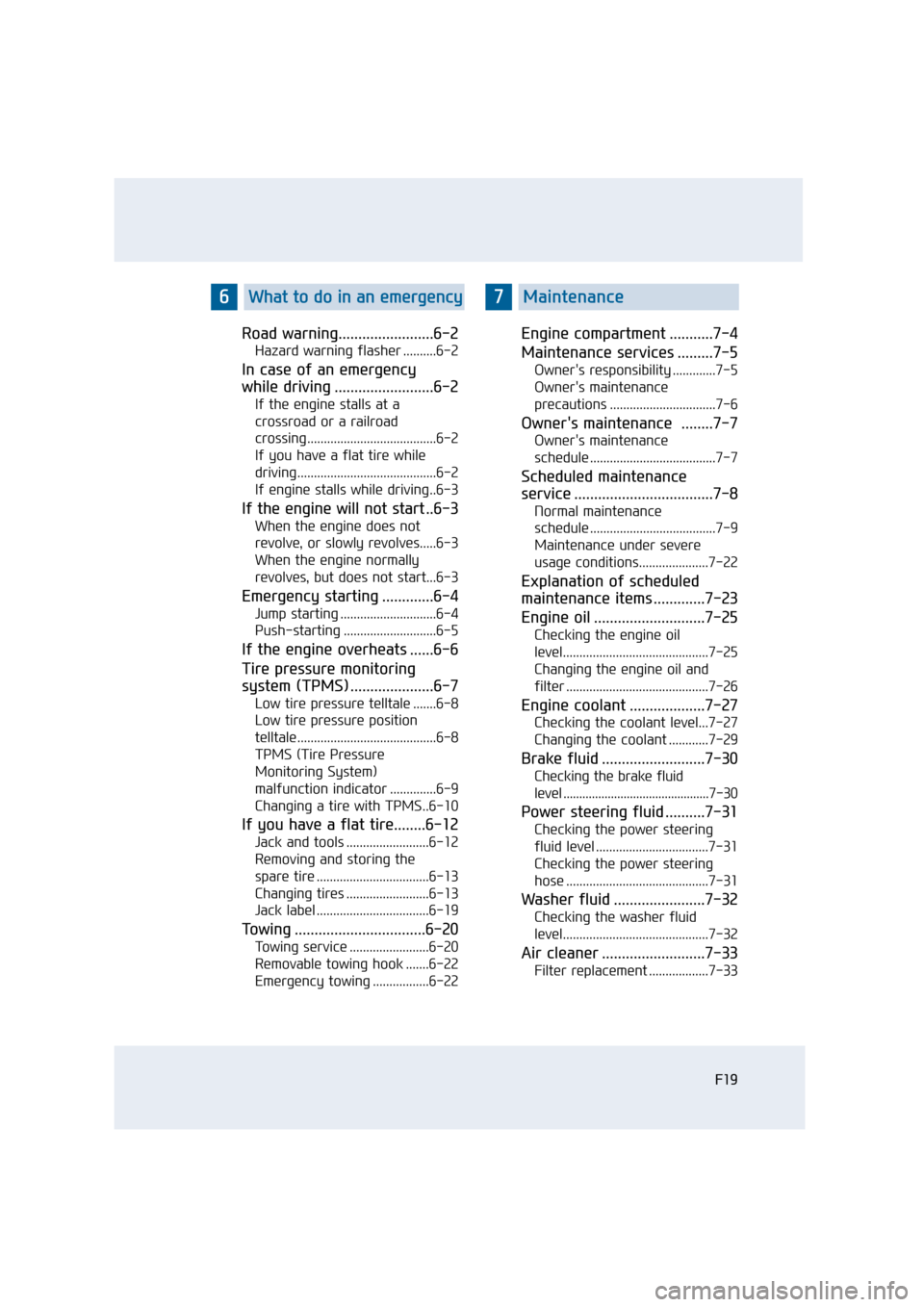
Road warning........................6-2
Hazard warning flasher ..........6-2
In case of an emergency
while driving .........................6-2
If the engine stalls at a
crossroad or a railroad
crossing.......................................6-2
If you have a flat tire while
driving..........................................6-2
If engine stalls while driving..6-3
If the engine will not start ..6-3
When the engine does not
revolve, or slowly revolves.....6-3
When the engine normally
revolves, but does not start...6-3
Emergency starting .............6-4
Jump starting .............................6-4
Push-starting ............................6-5
If the engine overheats ......6-6
Tire pressure monitoring
system (TPMS) .....................6-7
Low tire pressure telltale .......6-8
Low tire pressure position
telltale..........................................6-8
TPMS (Tire Pressure
Monitoring System)
malfunction indicator ..............6-9
Changing a tire with TPMS..6-10
If you have a flat tire........6-12
Jack and tools .........................6-12
Removing and storing the
spare tire ..................................6-13
Changing tires .........................6-13
Jack label ..................................6-19
Towing .................................6-20
Towing service ........................6-20
Removable towing hook .......6-22
Emergency towing .................6-22
Engine compartment ...........7-4
Maintenance services .........7-5
Owner's responsibility .............7-5
Owner's maintenance
precautions ................................7-6
Owner's maintenance ........7-7
Owner's maintenance
schedule ......................................7-7
Scheduled maintenance
service ...................................7-8
Normal maintenance
schedule ......................................7-9
Maintenance under severe
usage conditions.....................7-22
Explanation of scheduled
maintenance items .............7-23
Engine oil ............................7-25
Checking the engine oil
level............................................7-25
Changing the engine oil and
filter ...........................................7-26
Engine coolant ...................7-27
Checking the coolant level...7-27
Changing the coolant ............7-29
Brake fluid ..........................7-30
Checking the brake fluid
level ..............................................7-30
Power steering fluid ..........7-31
Checking the power steering
fluid level ..................................7-31
Checking the power steering
hose ...........................................7-31
Washer fluid .......................7-32
Checking the washer fluid
level............................................7-32
Air cleaner ..........................7-33
Filter replacement ..................7-33
F19
6What to do in an emergency7Maintenance
Page 22 of 477
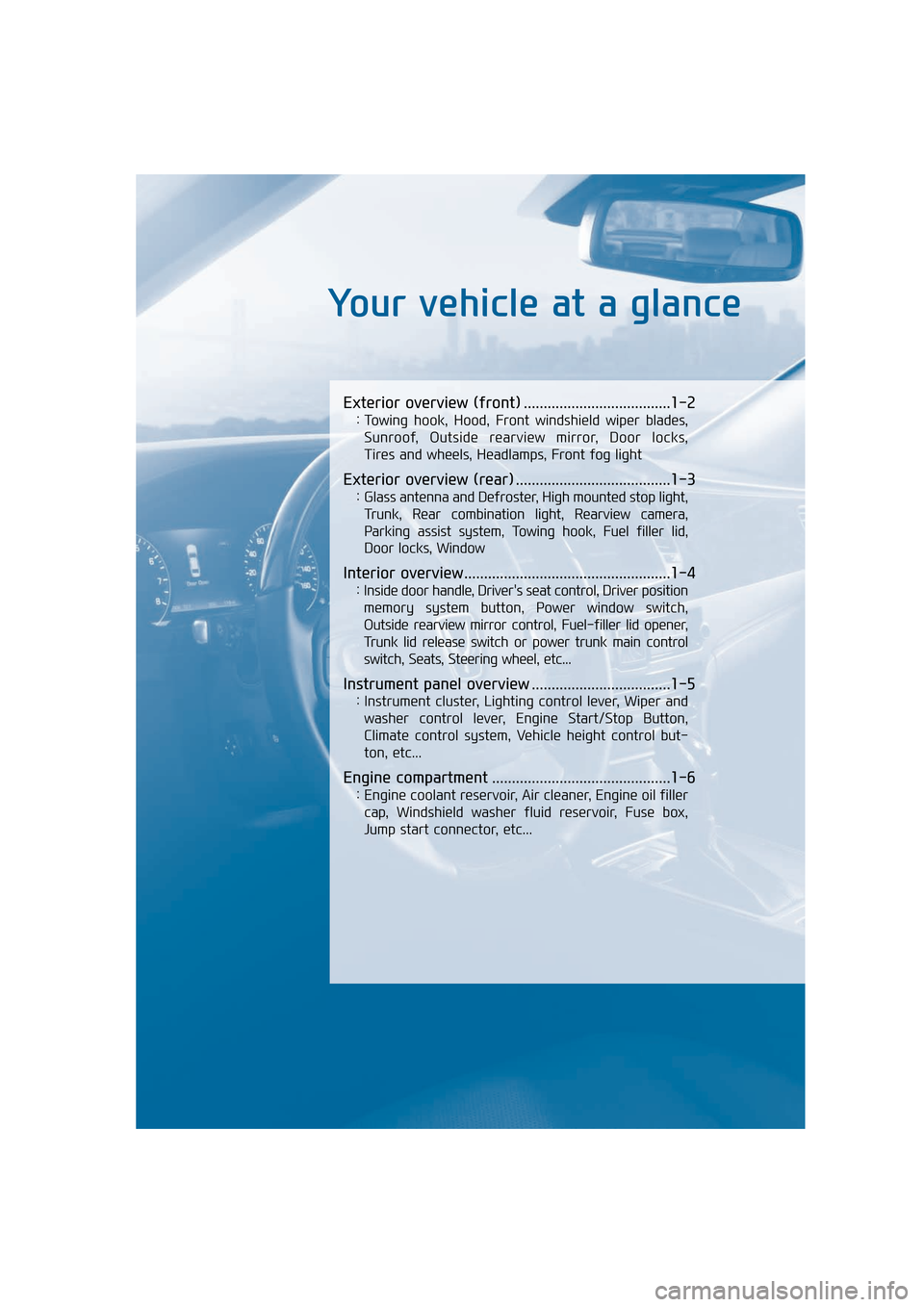
Your vehicle at a glance
Exterior overview (front) .....................................1-2
: Towing hook, Hood, Front windshield wiper blades, Sunroof, Outside rearview mirror, Door locks,
Tires and wheels, Headlamps, Front fog light
Exterior overview (rear) .......................................1-3
: Glass antenna and Defroster, High mounted stop light, Trunk, Rear combination light, Rearview camera,
Parking assist system, Towing hook, Fuel filler lid,
Door locks, Window
Interior overview ....................................................1-4
: Inside door handle, Driver's seat control, Driver position memory system button, Power window switch,
Outside rearview mirror control, Fuel-filler lid opener,
Trunk lid release switch or power trunk main control
switch, Seats, Steering wheel, etc...
Instrument panel overview ...................................1-5
: Instrument cluster, Lighting control lever, Wiper and washer control lever, Engine Start/Stop Button,
Climate control system, Vehicle height control but-
ton, etc...
Engine compartment .............................................1-6
: Engine coolant reservoir, Air cleaner, Engine oil fillercap, Windshield washer fluid reservoir, Fuse box,
Jump start connector, etc...
Page 25 of 477
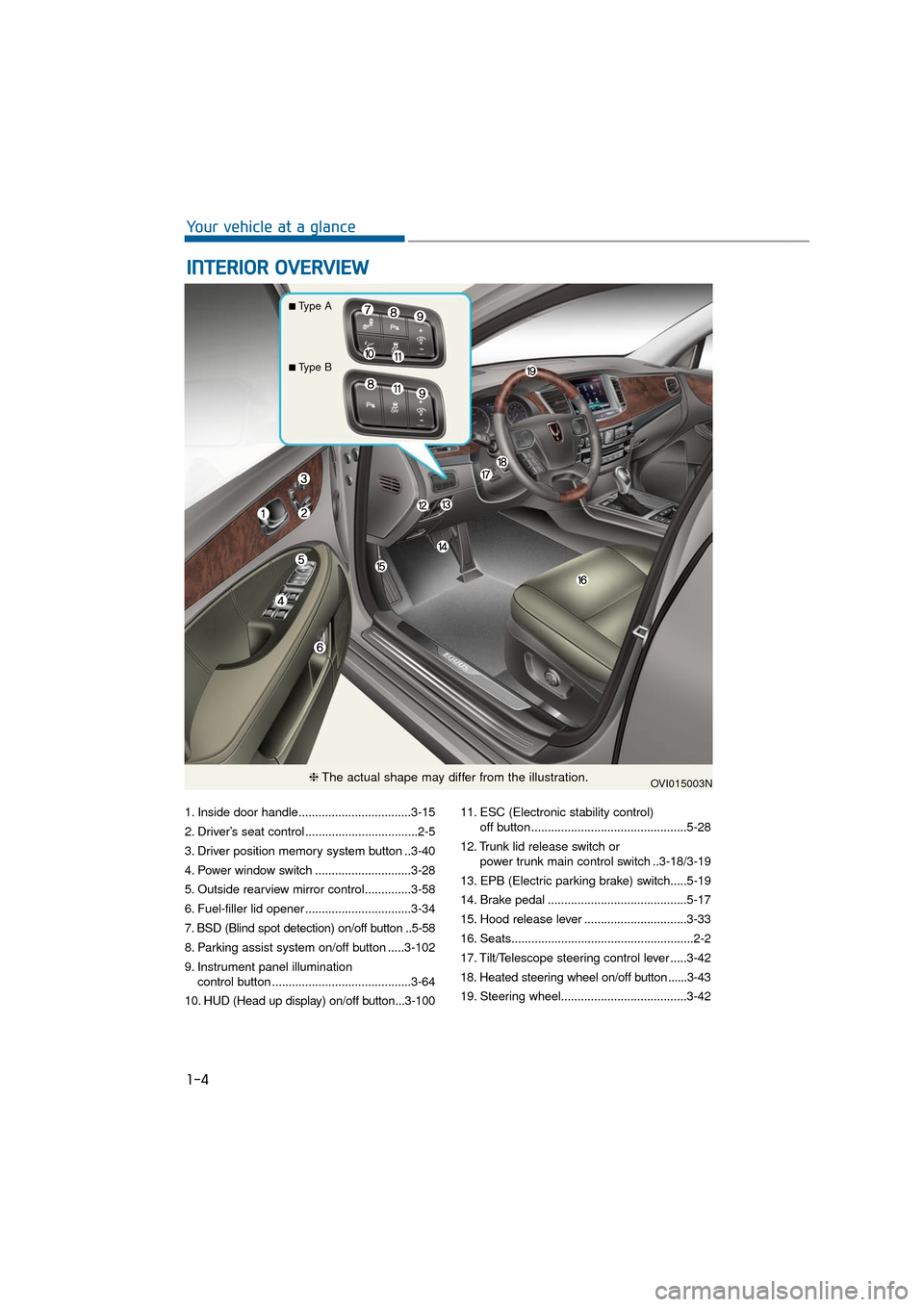
1. Inside door handle..................................3-15
2. Driver’s seat control ..................................2-5
3. Driver position memory system button ..3-40
4. Power window switch .............................3-28
5. Outside rearview mirror control..............3-58
6. Fuel-filler lid opener ................................3-34
7. BSD (Blind spot detection) on/off button ..5-58
8. Parking assist system on/off button .....3-102
9. Instrument panel illumination control button ..........................................3-64
10. HUD (Head up display) on/off button...3-100 11. ESC (Electronic stability control)
off button...............................................5-28
12. Trunk lid release switch or power trunk main control switch ..3-18/3-19
13. EPB (Electric parking brake) switch.....5-19
14. Brake pedal ..........................................5-17
15. Hood release lever ...............................3-33
16. Seats.......................................................2-2
17. Tilt/Telescope steering control lever .....3-42
18. Heated steering wheel on/off button ......3-43
19. Steering wheel......................................3-42
I I N
N T
TE
ER
R I
IO
O R
R
O
O V
VE
ER
R V
V I
IE
E W
W
1-4
Your vehicle at a glance
OVI015003N
■Type A
■Type B
❈ The actual shape may differ from the illustration.
Page 27 of 477
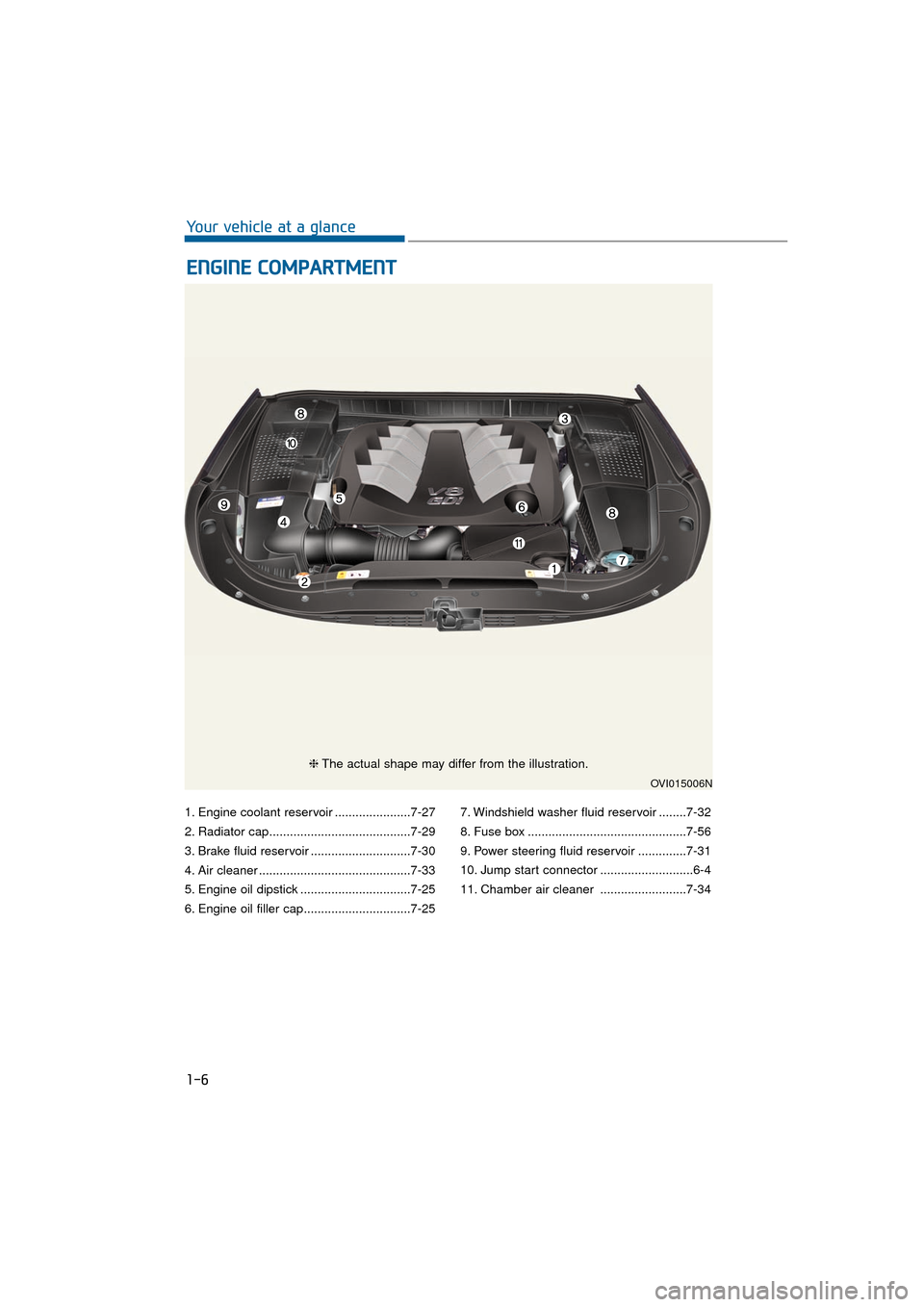
1. Engine coolant reservoir ......................7-27
2. Radiator cap.........................................7-29
3. Brake fluid reservoir .............................7-30
4. Air cleaner ............................................7-33
5. Engine oil dipstick ................................7-25
6. Engine oil filler cap...............................7-257. Windshield washer fluid reservoir ........7-32
8. Fuse box ..............................................7-56
9. Power steering fluid reservoir ..............7-31
10. Jump start connector ...........................6-4
11. Chamber air cleaner .........................7-34
E E
N
N G
GI
IN
N E
E
C
C O
O M
M P
PA
A R
RT
TM
M E
EN
N T
T
1-6
Your vehicle at a glance
OVI015006N
❈ The actual shape may differ from the illustration.
Page 31 of 477
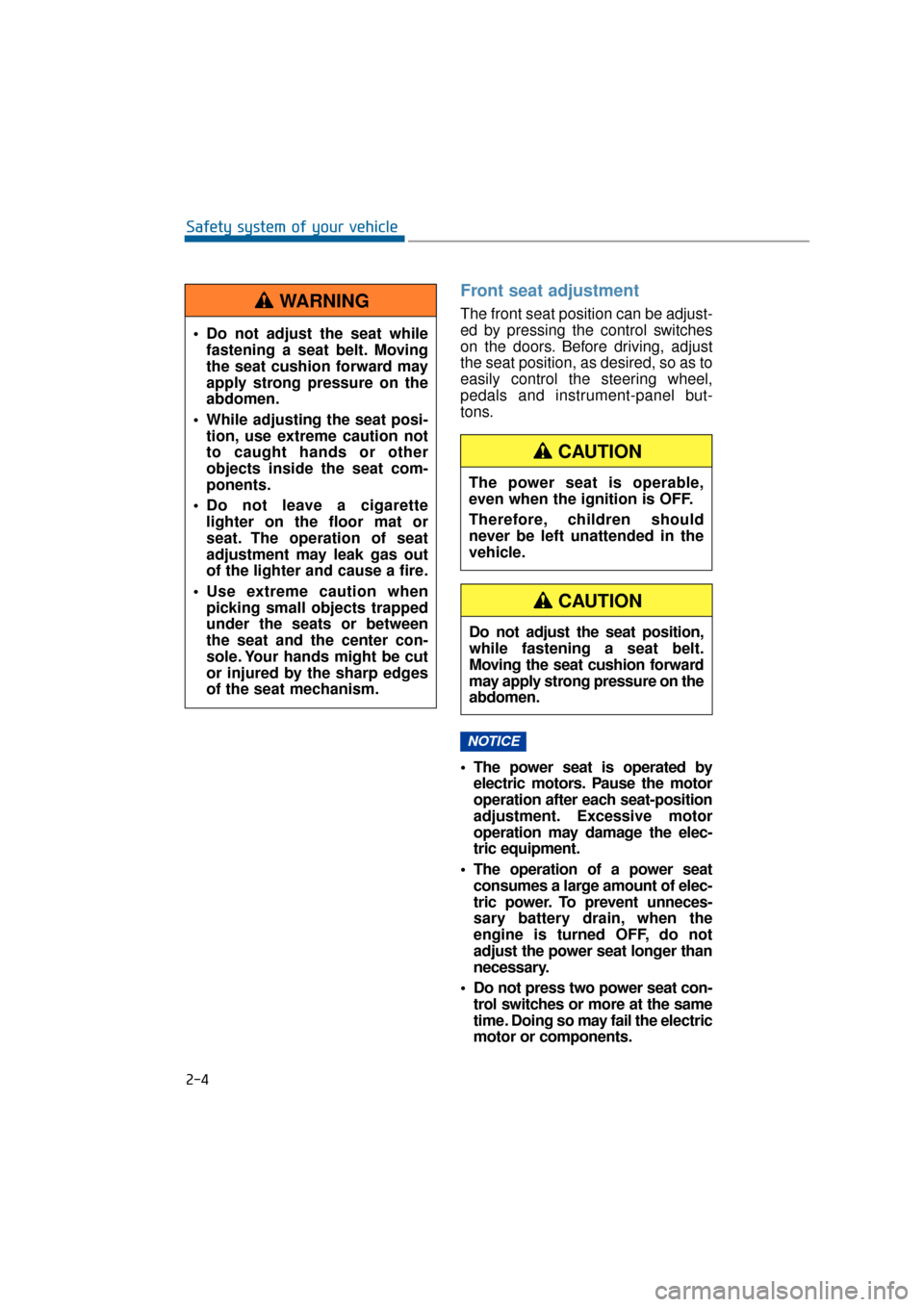
Front seat adjustment
The front seat position can be adjust-
ed by pressing the control switches
on the doors. Before driving, adjust
the seat position, as desired, so as to
easily control the steering wheel,
pedals and instrument-panel but-
tons.
The power seat is operated byelectric motors. Pause the motor
operation after each seat-position
adjustment. Excessive motor
operation may damage the elec-
tric equipment.
The operation of a power seat consumes a large amount of elec-
tric power. To prevent unneces-
sary battery drain, when the
engine is turned OFF, do not
adjust the power seat longer than
necessary.
Do not press two power seat con- trol switches or more at the same
time. Doing so may fail the electric
motor or components.
NOTICE
2-4
Safety system of your vehicle
Do not adjust the seat while fastening a seat belt. Moving
the seat cushion forward may
apply strong pressure on the
abdomen.
While adjusting the seat posi- tion, use extreme caution not
to caught hands or other
objects inside the seat com-
ponents.
Do not leave a cigarette lighter on the floor mat or
seat. The operation of seat
adjustment may leak gas out
of the lighter and cause a fire.
Use extreme caution when picking small objects trapped
under the seats or between
the seat and the center con-
sole. Your hands might be cut
or injured by the sharp edges
of the seat mechanism.
WARNING
Do not adjust the seat position,
while fastening a seat belt.
Moving the seat cushion forward
may apply strong pressure on the
abdomen.
CAUTION
The power seat is operable,
even when the ignition is OFF.
Therefore, children should
never be left unattended in the
vehicle.
CAUTION
Page 97 of 477
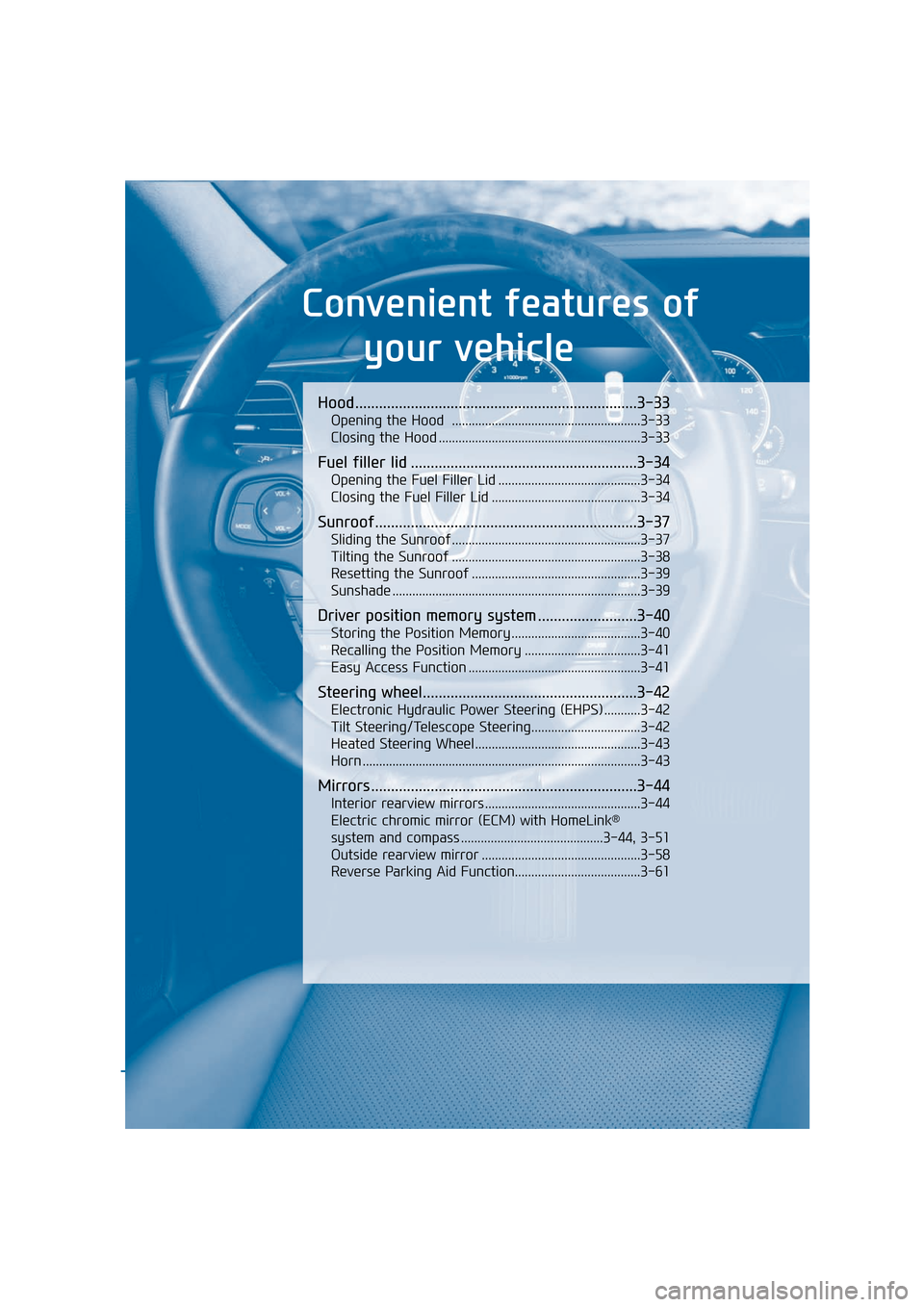
Hood.......................................................................3\
-33
Opening the Hood .........................................................3-33
Closing the Hood .............................................................3-33
Fuel filler lid .........................................................3-34
Opening the Fuel Filler Lid ...........................................3-34
Closing the Fuel Filler Lid .............................................3-34
Sunroof..................................................................3-37
Sliding the Sunroof .........................................................3-37
Tilting the Sunroof .........................................................3-38
Resetting the Sunroof ...................................................3-39
Sunshade ........................................................................\
...3-39
Driver position memory system .........................3-40
Storing the Position Memory .......................................3-40
Recalling the Position Memory ...................................3-41
Easy Access Function ....................................................3-41
Steering wheel......................................................3-42
Electronic Hydraulic Power Steering (EHPS) ...........3-42
Tilt Steering/Telescope Steering.................................3-42
Heated Steering Wheel ..................................................3-43
Horn ........................................................................\
............3-43
Mirrors ...................................................................3-44
Interior rearview mirrors ...............................................3-44
Electric chromic mirror (ECM) with HomeLink®
system and compass ...........................................3-44, 3-51
Outside rearview mirror ................................................3-58
Reverse Parking Aid Function......................................3-61
Convenient features of your vehicle
Page 137 of 477
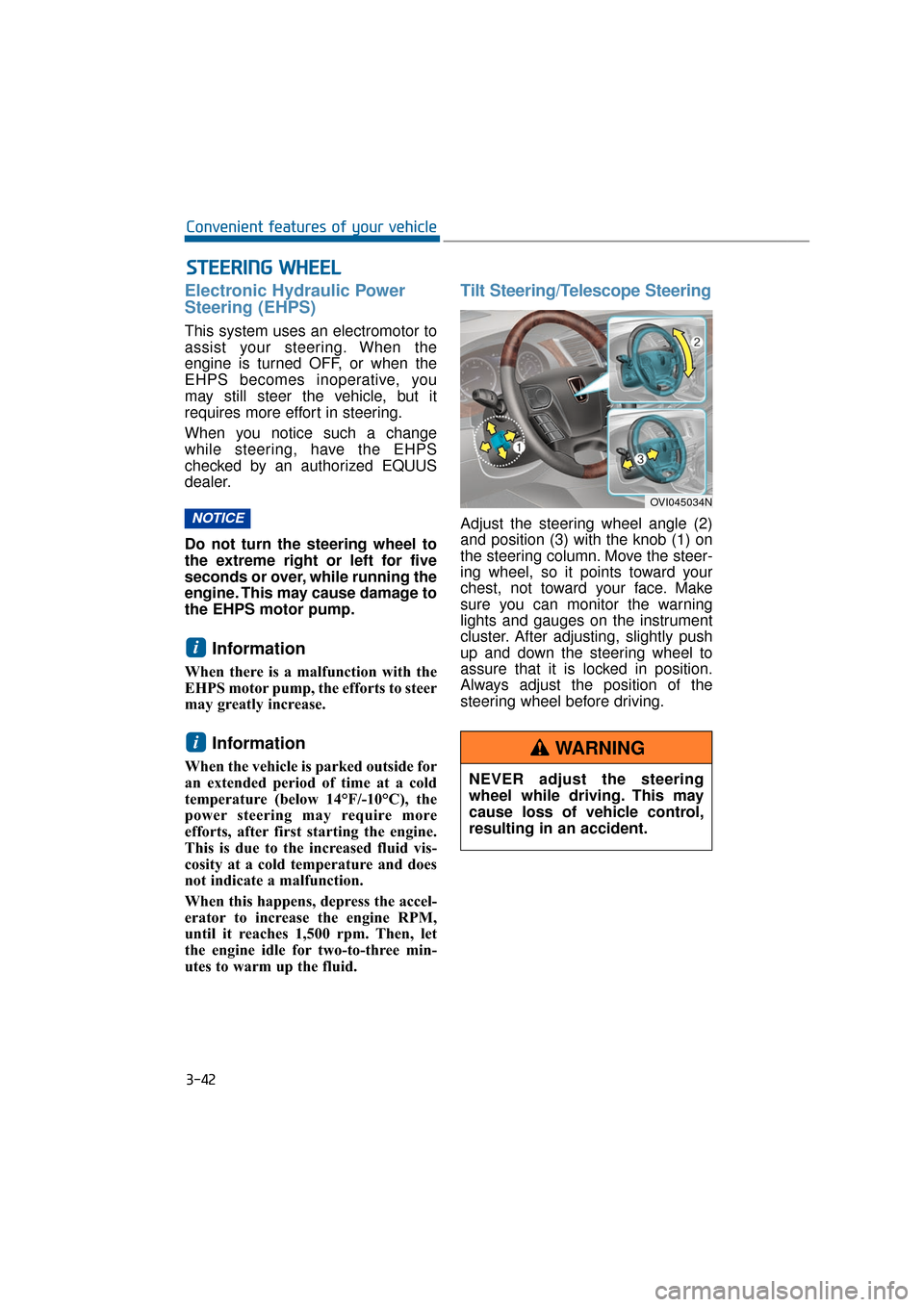
Electronic Hydraulic Power
Steering (EHPS)
This system uses an electromotor to
assist your steering. When the
engine is turned OFF, or when the
EHPS becomes inoperative, you
may still steer the vehicle, but it
requires more effort in steering.
When you notice such a change
while steering, have the EHPS
checked by an authorized EQUUS
dealer.
Do not turn the steering wheel to
the extreme right or left for five
seconds or over, while running the
engine. This may cause damage to
the EHPS motor pump.
Information
When there is a malfunction with the
EHPS motor pump, the efforts to steer
may greatly increase.
Information
When the vehicle is parked outside for
an extended period of time at a cold
temperature (below 14°F/-10°C), the
power steering may require more
efforts, after first starting the engine.
This is due to the increased fluid vis-
cosity at a cold temperature and does
not indicate a malfunction.
When this happens, depress the accel-
erator to increase the engine RPM,
until it reaches 1,500 rpm. Then, let
the engine idle for two-to-three min-
utes to warm up the fluid.
Tilt Steering/Telescope Steering
Adjust the steering wheel angle (2)
and position (3) with the knob (1) on
the steering column. Move the steer-
ing wheel, so it points toward your
chest, not toward your face. Make
sure you can monitor the warning
lights and gauges on the instrument
cluster. After adjusting, slightly push
up and down the steering wheel to
assure that it is locked in position.
Always adjust the position of the
steering wheel before driving.
i
i
NOTICE
S ST
T E
EE
ER
R I
IN
N G
G
W
W H
HE
EE
EL
L
3-42
Convenient features of your vehicle
OVI045034N
NEVER adjust the steering
wheel while driving. This may
cause loss of vehicle control,
resulting in an accident.
WARNING
Page 182 of 477
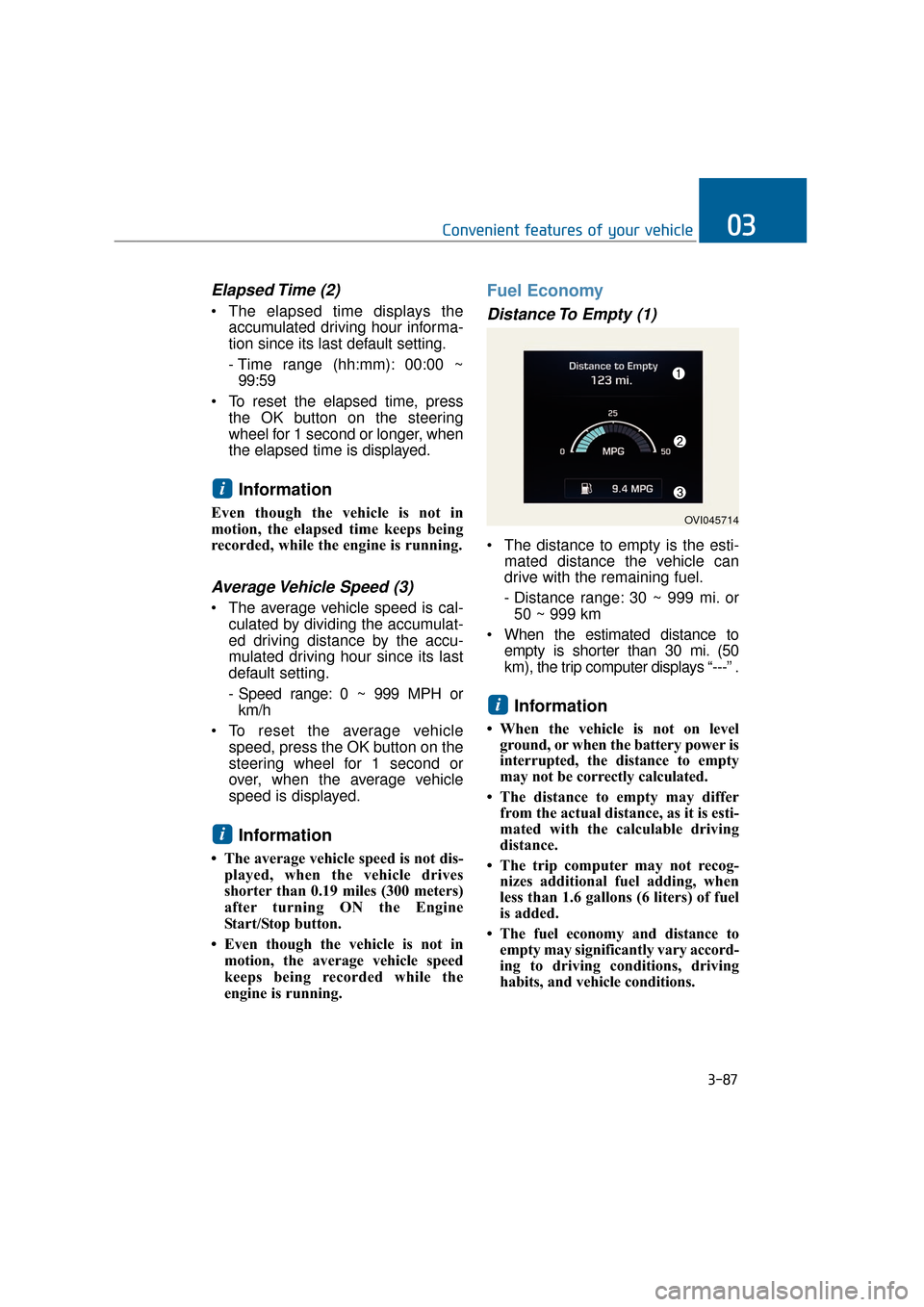
Elapsed Time (2)
The elapsed time displays theaccumulated driving hour informa-
tion since its last default setting.
- Time range (hh:mm): 00:00 ~99:59
To reset the elapsed time, press the OK button on the steering
wheel for 1 second or longer, when
the elapsed time is displayed.
Information
Even though the vehicle is not in
motion, the elapsed time keeps being
recorded, while the engine is running.
Average Vehicle Speed (3)
The average vehicle speed is cal-culated by dividing the accumulat-
ed driving distance by the accu-
mulated driving hour since its last
default setting.
- Speed range: 0 ~ 999 MPH orkm/h
To reset the average vehicle speed, press the OK button on the
steering wheel for 1 second or
over, when the average vehicle
speed is displayed.
Information
• The average vehicle speed is not dis-played, when the vehicle drives
shorter than 0.19 miles (300 meters)
after turning ON the Engine
Start/Stop button.
• Even though the vehicle is not in motion, the average vehicle speed
keeps being recorded while the
engine is running.
Fuel Economy
Distance To Empty (1)
The distance to empty is the esti- mated distance the vehicle can
drive with the remaining fuel.
- Distance range: 30 ~ 999 mi. or50 ~ 999 km
When the estimated distance to empty is shorter than 30 mi. (50
km), the trip computer displays “---” .
Information
• When the vehicle is not on levelground, or when the battery power is
interrupted, the distance to empty
may not be correctly calculated.
• The distance to empty may differ from the actual distance, as it is esti-
mated with the calculable driving
distance.
• The trip computer may not recog- nizes additional fuel adding, when
less than 1.6 gallons (6 liters) of fuel
is added.
• The fuel economy and distance to empty may significantly vary accord-
ing to driving conditions, driving
habits, and vehicle conditions.
i
i
i
3-87
Convenient features of your vehicle03
OVI045714